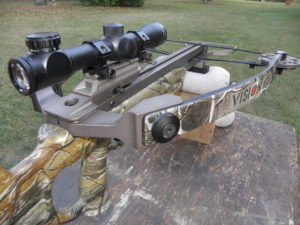The Archery Advantage: Crossbows
By Glen Wunderlich
Michigan’s archery season is a little over a month away, and for many hunters, that means practice. With typical vertical bows – not the newer vertical crossbows – it also means developing muscles seldom used in other physical activity. Plus, that most valuable commodity we all seem to have so little of is the devotion of time – all the more reason to strongly consider the advantages of modern crossbows. If you’re prone to traditionalism, more power to you, but my conversion took place a decade ago and I’ve never looked back.
I never appreciated the arduous tasks involved with preparations relative to conventional stick and string hunting; it was merely a means to an end. I’ve owned the same crossbow, since they became legal years ago and getting ready is only a matter of confirming it’s on target when the trigger is pulled. It affords me extreme accuracy with less effort.

Horton Vision Crossbow Shooting from Rest
Without getting into other comparisons between vertical equipment and crossbows, I appreciate two decided advantages: They’re always ready and they can be shot from a rest. Both of these features fit hand-in-hand with the DNR’s push for hunters to take more deer, as a means to minimize the spread of Chronic Wasting Disease (CWD).
Vertical bows must be drawn when a deer is within range. That means the quarry is also within range to spot the movement required or to detect any sound emitted in the process. Putting whitetails on high alert is problematic and can mean misses or the despised wounding. Shooting from a rest, similar to that available with firearms, minimizes the possibility of human error.
One more crossbow advantage is worth mentioning: Youngsters can get involved in big-game hunting effectively without abusive recoil or noise. To fight CWD or simply to carry on the time-honored hunting tradition to manage our deer herd, we’ll need young adults to enter the hunting fraternity, as seasoned citizens inevitably retire.
Becoming familiar with the equipment on level ground at 20 yards is a good way to start. However, heading afield to actual stands to be used during season is better. Some stands may be elevated and some shots will be presented at ranges either less or more than 20 yards. Although crossbows have scopes mounted on them and many have yardage increments as part of their reticles, they are not necessarily calibrated for the weight and speed of the bolt (arrow) being used. Even though rangefinders are in common use today and are highly recommended, they can only confirm distance. Practice afield will confirm known distance in conjunction with the reticle’s aiming points; there is no sure-fire means to assume otherwise.
Worth repeating season-to-season is one final rule to let anyone realize that he or she is qualified to take an animal’s life, apart from any emotional considerations. It is a measure of skill that determines if one is good enough – a barometer of competence, if you will, that applies to any “tool” used for taking game, be it archery equipment or any firearm: the 9 out of 10 rule. Simply stated, if 9 out of 10 shots can be placed into a conservative 6-inch circle at any given range with adequate energy at that range, a person is ready to hunt. If not, that person must get closer to the target until the rule is satisfied and that becomes the ethical limit in range for that hunter. No excuses.
